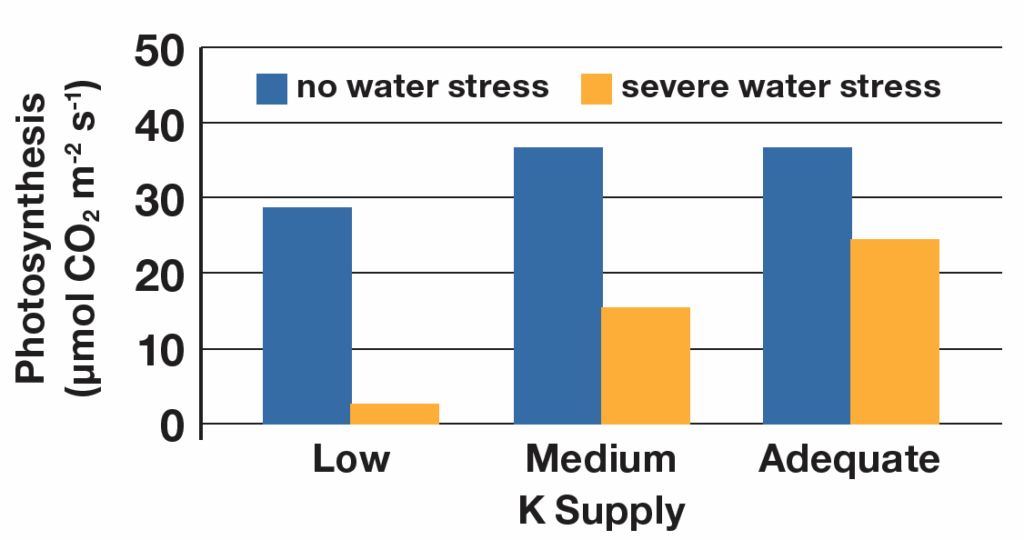The Role of Potassium in Drought Resilience
Potassium is crucial in maintaining osmotic balance and supporting photosynthesis, particularly under drought conditions. Studies in many crops show how K deficiency aggravates drought stress by impairing osmoregulation and disrupting photosynthetic carbon metabolism2,3,4. Potassium facilitates efficient water use in plants by maintaining cellular turgor pressure even as water availability declines.
Under drought stress, plants with adequate K levels show improved photosynthesis due to enhanced carbon dioxide (CO2) uptake, which is facilitated by more reactive stomates (Figure 1)2. Potassium also assists in maintaining the function of the enzyme Rubisco, which is essential for carbon fixation during photosynthesis. When K is limited, Rubisco’s efficiency declines, resulting in decreased photosynthetic rates and subsequent reductions in crop yield.
Because photosynthesis efficiency is reduced during drought, plants rely more heavily on carbohydrates stored in stalks which can lead to greater lodging. However, crops grown with sufficient available potassium (Figures 2&3)4 are better able to facilitate the storage of carbohydrates in stems and leaves which enhances their re-mobilization to grains or fruits, especially critical during grain-filling stages under water stress. This storage and re-mobilization strategy enables plants to reduce lodging, while maintaining reproductive growth and productivity even as photosynthetic activity declines.

Figure 1: Where potassium goes, water follows. Potassium regulates water loss and photosynthesis efficiency of plants through stomate opening and closing. Karki, 2020.

Figure 2: Comparison of measured photosynthesis in plants that were supplied with different levels of potassium. Sen Gupta et al., 1989, Plant Physiology.

Figure 3: Lodging in wheat grown in a low-K soil. Lodging is noticeable in the lower K rate treatments of 10, 25, and 75 mg/kg. Cakmak & Rengel, 2024.
Boron: A Vital Micronutrient in Drought Stress Alleviation
While potassium’s role in managing drought is well-understood, recent research by Aydin et.al. highlights boron’s importance in enhancing drought resilience in plants. Although required in lesser amounts, B significantly influences plant structural integrity and stress response mechanisms. Boron enhances the stability of cell walls, supports membrane functions, and is critical in the synthesis of lignin and pectin, components that fortify cell walls against dehydration. This can be especially critical during reproductive stages when drought conditions aggravate B deficiencies and restrict pollen development.
Plants under water-deficient conditions often suffer from compromised cell wall structure, leading to reduced growth and productivity. Sufficient B in plants maintains cell wall strength, allowing cells to withstand osmotic stress more effectively. By also stabilizing cell membranes, B reduces water loss through evaporation, improves antioxidant enzyme activity, increases related gene expression, and thereby strengthens the plant’s ability to counteract stress. Such biochemical responses are vital in drought scenarios, as B strengthens the plant’s natural defenses by reducing cellular damage.
Advanced Crop Nutrition Improves Plant Stress Tolerance
The integration of balanced crop nutrition and biological functionality of soils working together to support plant functions, including improved stress tolerance and yield is what we at Mosaic call Advanced Crop Nutrition. Plant Growth-Promoting Rhizobacteria (PGPR) have emerged as a valuable biological tool for enhancing drought resilience in crops. These beneficial microbes colonize plant roots and form symbiotic relationships that improve nutrient uptake, water retention, and stress tolerance, thus supporting the efficient use of K and B in drought-stressed plants5. Science is uncovering many ways in which PGPR can assist plants in having greater drought tolerance5. A few specific instances include research showing that there are Bacillus strains that support stomatal regulation along with nutrient uptake which allows plants to optimize water use efficiency. Certain PGPR strains produce organic acids and other exudates that solubilize K and B from minerals, making them more available to plants. Additionally, research with PGPR has shown enhanced root growth that can help mitigate late-season water and nutrient stress while maintaining higher levels of photosynthesis5.
Advanced Crop Nutrition Enhances Crop Drought Resilience
The integration of K and B into crop management strategies can improve drought resilience. Applying granular fertilizers such as Aspire® (0-0-58-0.5B) can optimize crop growth by increasing K availability in the soil to enhance root development, water uptake, and provide uniform distribution of two forms of boron for season-long B availability. Research continues to emphasize that a balanced crop nutrition program incorporating both K and B can mitigate drought’s adverse effects. The synergistic effects of these nutrients enhance overall plant resilience, with potassium supporting energy production and carbohydrate management while boron helps increase cellular stability and antioxidant defense. With increasingly erratic rainfall and prolonged dry seasons, research continues to demonstrate that planned K and B applications are not just supplementary; they are essential components of resilient agricultural systems. Integrating K and B management with PGPR promotes a more resilient, sustainable agricultural system that can meet the demands of future food, fuel, and fiber needs. By improving nutrient uptake, antioxidant defenses, and soil moisture retention, K, B, and PGPR serve as essential components in drought adaptation strategies and sustainable agriculture production.
References:
1. Aydin, M., Tombuloglu, G., Sakcali, M.S., et. al. (2019). Boron alleviates drought stress by enhancing gene expression and antioxidant enzyme activity. J. of Soil Science and Plant Nutrition. 19: 545-555.
2. Karki, G. (2020). Transpiration in plants: types, mechanism, affecting factors and significance. https://images.slideplayer.com/23/6659542/slides/slide_12.jpg.
3. Sen Gupta, A., Berkowitz, G. A., & Pier, P. A. (1989). Maintenance of photosynthesis at low leaf water potential in wheat. Plant Physiology. 89: 1358–1365.
4. Cakmak, I., & Rengel, Z. (2024). Potassium may mitigate drought stress by increasing stem carbohydrates and their mobilization into grains. Journal of Plant Physiology. 303. 154325.
5. Ojuederie, O. B., Olanrewaju, O. S., & Babalola, O. O. (2019). Plant growth-promoting rhizobacterial mitigation of drought stress in crop plants: Implications for sustainable agriculture. Agronomy. 9: (11), 712.
©2025 The Mosaic Company. All rights reserved. Aspire is a registered trademark of The Mosaic Company.
AgriSight is a registered trademark of the Mosaic Company. Trusted Crop Nutrition Expertise is a service mark of The Mosaic Company.